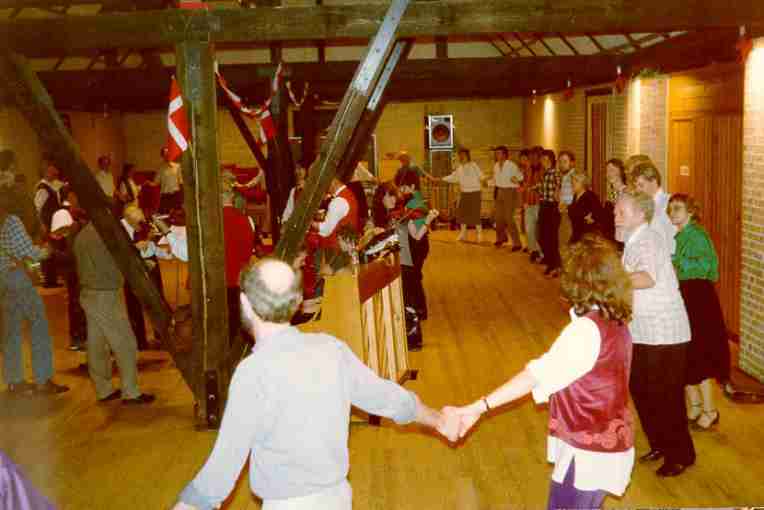Hamborg 6-tur (Hamburg 6-trip) |
| Niels Mejlhede Jensen, Bøgeløvsvej 4, 2830 Virum, Denmark. e-mail (web master) |
CONTENTS: (remember: you can use Ctrl Home in usual browsers to get to the top of this page, to the links here)

Photo of this week: the dance of this week, Hamborg 6-tur (Hamburg
6-trip) is danced in a former barn by Fiddlers' Dance.
Dance of the week, 1999, May 10:
The melody can be heard in midi on computer piano in my tempo (if you
have a sound card). (The melody will loop here until you stop it. In the
table below it will play once). (I have not played the tunes here with
the "drive" I want for dance music).
| 1 | melody | the traditional good dancing melody, polished through generations of use on the fiddle | |
| . | chord
text |
Midi metronome = 110 | simple (folk music) chords, natural for playing the accordion;
these chords are used to make the other parts or voices in triad harmony; there should be no tension from dissonance anywhere including in octave |
| 2 | A | (Above), parallel part nearest above in third or little more above | |
| 3 | B | (Below), parallel part nearest below in third or little more below | |
| 4 | ns | simple n part; often with the tonic feeling and often with the basic dance rhythm ("motor part") | |
| 5 | C1 | C parts are made from A and B parts, and so they are two parts to the melody | |
| 6 | mod =
contra part |
voice up and down (mostly) contra to the melody; it is also made from A and B | |
| 7 | n1 | n is a less constricted part, and tones from the melody are freely included | |
| 8 | nss | simple ns part | |
| 9 | As | simplified A part | |
| 10 | Bs | simplified B part | |
| 11 | melody' | simplified melody;
should be easier to play and still sound like the melody |
|
| 12 | blank | . | blank staff for making your own part according to the principles here |
(The midi music is not repeated, except for 1' and 2' voltas).
Use also octave, up and down.
Where wanted, notes can be changed according to the principles (use
a colour pencil), e.g. to improve the B part with some notes from
A.
The music is aimed at dancing, so part of the orchestra can be the
underlying "motor" when another instrument group is playing its "solo"
part (improvisation) as one of the many repetitions.
The double bass may play its usual notes, because of its low pitch.
It is better to choose a more simple part and play it well.
The melody to this popular dance can be felt to be rather tough to play in its fast tempo, so I have made a simplified melody. If you want, then leave out also all the (second) semiquavers (1/16 note).
(The music note sheet for the right page is congested and ought to be
on two pages; but that is not so easy for a book).
Accordion: beats per bar: 2+2
(Help coming back from that note
sheet: CLICK the note sheet to come back to this page, or just close
the note window.
Remember: the note sheet opens in a new separate window, and that may
cover the whole screen. The back button in the tools bar does probably
not work because the window is new, with no history. All you see on the
page are notes because I have placed no link back here for not disturbing
easy submitting to the printer. Close the note window with a click at the
top or with Alt F4, or minimize or reduce the window, or ..., and you are
back to the main page that was there behind all the time).